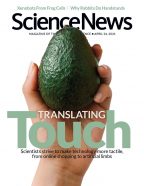
Explosive snowflakes
Tiny uranium crystals in the cores of white dwarf stars could trigger nuclear reactions that blow the stars apart, Emily Conover reported in “Uranium ‘snowflakes’ might spark supernovas” (SN: 4/24/21, p. 5).
Two main types, or isotopes, of uranium on Earth are uranium-238 and uranium-235. But only uranium-235 is fissile, or can sustain a fission chain reaction, reader Leon Maya noted, and this isotope is less common. Maya wondered if the relationship between the isotopes also extends to white dwarfs.
The short answer is yes, Conover says. Since uranium-235 is fissile, it is the isotope that could set off explosions in white dwarfs. And because it decays more quickly than uranium-238, uranium-235 is typically less abundant, whether on Earth or in white dwarfs.
In general, scientists think that much of the uranium present in planets and stars formed from neutron star mergers (SN: 11/11/17, p. 6). Earth has a low concentration of uranium-235 because the merger that forged its uranium happened quite a long time ago, Conover says. “But a white dwarf that formed soon after a neutron star merger would have a significantly higher uranium-235 fraction than that on Earth.”
Tuning in to the cosmos
A distant galaxy cluster emits an unusual radio wave pattern that is shaped like a giant jellyfish, Ken Croswell reported in “ ‘USS Jellyfish’ is a cosmic oddball” (SN: 4/24/21, p. 10).
Astronomers can detect the cluster at frequencies similar to those of FM radio stations, Croswell reported. Reader Mike Neary wondered why researchers consider these radio frequencies low, given that the frequencies reside in the International Telecommunication Union’s “very high frequency” band, which ranges from 30 to 300 megahertz.
Radio frequencies from 30 to 300 MHz are high for Earth but low for the cosmos, Croswell says. Take the Low Frequency Array, or LOFAR. This radio telescope network detects cosmic frequencies between 10 and 240 MHz, the lowest frequencies observable from Earth. In contrast, the best-known frequency in radio astronomy, emitted by hydrogen atoms in space, is 1,420 MHz, a wavelength of 21 centimeters.
Video killed the radio star
Zoom and the COVID-19 pandemic helped usher in a new age of videocalling, a technology that consumers had rejected for decades, Anushree Dave reported in “What took the videophone so long to catch on?” (SN: 4/24/21, p. 22).
Several readers reflected on the technology’s social impact and what videocalling could mean for the future.
Reader Leah O’Connor lauded the benefits videocalling provides for people who are deaf or have low hearing. “Zoom and some other platforms now have computer-generated captioning that is almost better than live captioning,” she wrote. “Videocalling also allows for lip reading and American Sign Language.… I hope videocalling never goes away.”
Though many people have relied on videocalling during the pandemic to foster a sense of togetherness and community, reader Mike Bushroe meditated on the negative associations with the technology that some people might develop. People may learn to connect videocalling with the trauma of the pandemic, Bushroe noted, including the shuttering of businesses and public venues, the isolation from loved ones, the economic impact of all the jobs lost and the risk of catching and possibly dying from the virus. Those negative associations might persist long after the pandemic, and people may have to heal from the trauma to “begin to think of Zoom meetings and get-togethers solely on their own merits,” he wrote.
While many readers looked ahead to videocalling’s future, Dave’s story reminded reader A. Michael Noll of his past as a researcher at Bell Telephone Laboratories and AT&T. “I published much about the Picturephone and worked on video conferencing [technology] in the 1970s,” Noll wrote. He even contributed to the videophone sequence in the 1968 film 2001: A Space Odyssey.


